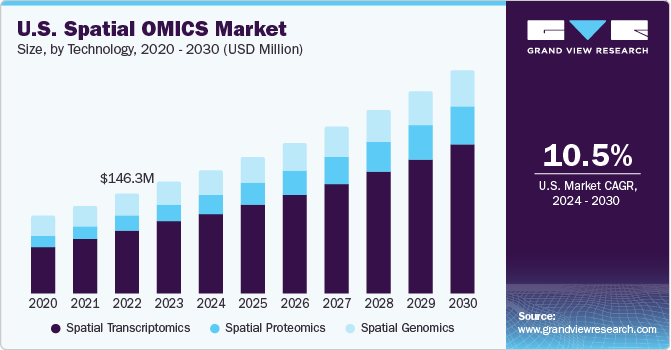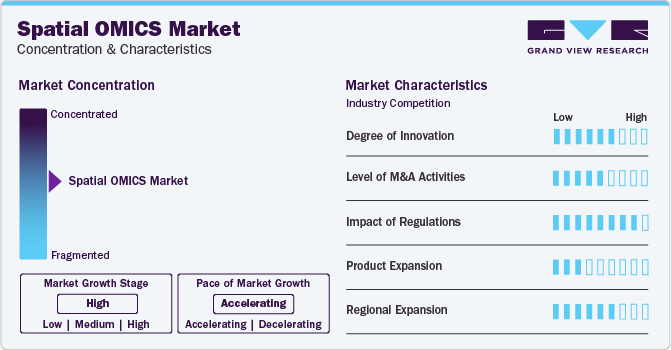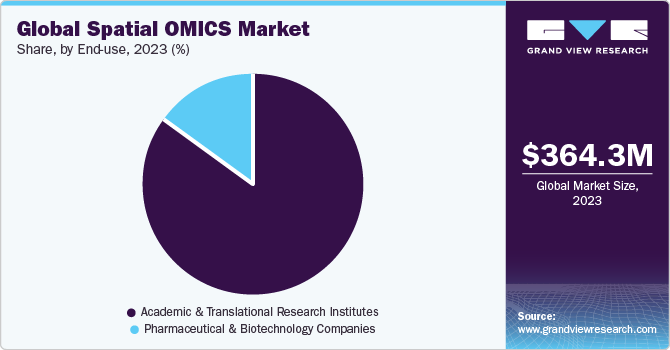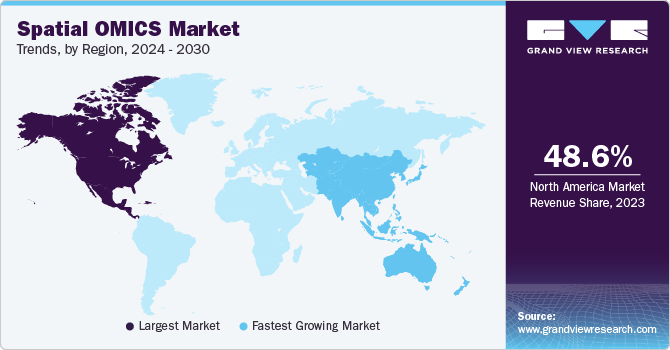- Home
- »
- Biotechnology
- »
-
Spatial OMICS Market Size, Share & Growth Report, 2030GVR Report cover
![Spatial OMICS Market Size, Share, & Trends Report]()
Spatial OMICS Market Size, Share, & Trends Analysis Report By Technology (Spatial Transcriptomics, Spatial Genomics, Spatial Proteomics), By Product, By Workflow, By Sample Type, By End-use, By Region, And Segment Forecasts, 2024 - 2030
- Report ID: GVR-4-68039-463-5
- Number of Report Pages: 120
- Format: PDF, Horizon Databook
- Historical Range: 2018 - 2023
- Forecast Period: 2024 - 2030
- Industry: Healthcare
Spatial OMICS Market Size & Trends
The global spatial OMICS market size was estimated at USD 364.3 million in 2023 and is projected to grow at a compound annual growth rate (CAGR) of 10.21% from 2024 to 2030. Spatial OMICS refers to a set of technologies that combine high-throughput molecular profiling with spatial information, enabling the analysis of biological samples in their spatial context. The market is driven by several factors, including the rising prevalence genetic illnesses, global advances in sequencing technologies, and increased financing for OMICS research.

The market for spatial OMICS is anticipated to rise due to its increased usage in drug research and development and its potential as a tool for cancer diagnosis. For instance, in June 2023, Owkin Inc. contributed USD 50 million and joined forces with NanoString Technologies, Inc. Research teams from European and American institutions and other organizations to use this technology for cutting-edge cancer research.
There have been notable advancements in technology, such as spatial proteomics, transcriptomics & genomics, which have improved the ability to analyze molecular information in tissues and cells at a spatial level. These technologies provide researchers with a more comprehensive understanding of complex biological systems. For instance, in February 2023, Curio Bioscience announced the introduction of Curio Seeker, the first high-resolution, whole-transcriptome spatial mapping kit, marking the start of the company's commercial activities.
Extensive research for understanding COVID-19 infections has turned attention to the application of spatial transcriptomics and other OMICS studies. For instance, in October 2020, researchers from the Massachusetts General Hospital analyzed the autopsy specimens obtained from around 24 COVID-19 patients using spatial transcriptomics technology to understand the SARS-CoV-2 infection. Several companies operating in the market offer various solutions for spatial OMICS studies. For instance, GeoMx Digital Spatial Profiler (DSP) was manufactured by NanoString to help quantify around 1,800 RNA targets, including COVID-19 proteases and receptors. In addition, with the system, researchers generated large data sets of tissue images and molecular data obtained from COVID-19 decedents. They compared them with the patients who passed away from similar diseases, such as MERS-CoV (2012), SARS-CoV, and other non-viral causes, facilitating a better understanding of the COVID-19 infection.
Cancer immunotherapy is also one of the primary drivers of the market. It is essential to conduct spatial multi-omics studies to understand the tumor immunogenicity of the complex tumor microenvironment. Companies are focusing on developing transformational approaches for cancer biomarker discovery. For instance, in January 2023, Akoya Biosciences, Inc. collaborated with Agilent Technologies, Inc., to design services and products for multiplex immunofluorescence and chromogenic tissue assays.
Market Concentration & Characteristics
The spatial OMICS market has witnessed several innovations in recent years. With the integration of advanced technologies such as artificial intelligence, machine learning, and computer vision, the market is experiencing a significant transformation. These innovations are driving the development of new tools and techniques that enable researchers to gain deeper insights into the spatial organization of biological systems. Additionally, the emergence of cloud computing and big data analytics is facilitating the processing and analysis of large volumes of spatial data, further fueling the growth of the spatial OMICS market.

Several companies are engaging in mergers and acquisitions to expand their product offerings and increase their market share. This trend is expected to continue in the coming years as the market grows and matures. The increasing demand for spatially resolved data and the emergence of new technologies are also driving the consolidation of the market.
The spatial OMICS market is highly regulated due to the potential ethical and legal issues surrounding handling of genetic and health data. Regulations can significantly impact the market as they can influence the development, approval, and commercialization of spatial OMICS technologies. Additionally, regulations can affect the accessibility and affordability of spatial OMICS technologies for patients and healthcare providers.
Immunohistochemistry (IHC) and Immunofluorescence (IF) techniques involve using antibodies to visualize specific proteins within tissues. While less high throughput than some spatial omics methods, IHC and IF provide spatial information about protein expression within tissues. In addition, traditional OMICS techniques, such as genomics, transcriptomics, and proteomics without spatial resolution, provide valuable molecular details on biological samples. While lacking spatial context, bulk OMICS methods are widely used and may be suitable for specific research questions.
Academic institutions, research universities, and laboratories are significant end users in the spatial OMICS market. The availability of funding influences the concentration of users in this sector, the adoption of new technologies, and collaborations between academia and industry. The spatial OMICS market interests biotechnology and pharmaceutical companies engaged in drug discovery, development, and biomarker research. Concentration among these end users is impacted by the specific needs of the pharmaceutical industry and the adoption of spatial OMICS technologies for target identification and validation.
Technology Insights
The spatial transcriptomics segment dominated and held the largest market share in 2023. Continuous advancements in sequencing technologies have accelerated the transcriptomic study of single cells. For the comprehensive study of multicellular organisms, efforts are being taken to design novel solutions for high-throughput genomic analysis while maintaining the spatial information of the sample/tissue under observation or subcellular localization of analyzed DNA/RNA.
Developing various in-situ methods enhances the capabilities to explore spatial information in biological investigation. These methods have led to the convergence of function-oriented biochemistry and molecular genetics fields with structure-focused fields such as histology and embryology, thereby enabling spatially resolved molecular investigation of biological processes. For instance, combining in-situ hybridization techniques with genetic tools helps explore the formation of gene expression gradients and embryonic axes at different developmental stages. The gradient formation helps in understanding embryonic development and organ formation. The spatial genomics segment is expected to expand at the highest CAGR throughout the forecast period. FISH is the most commonly used method for spatial genomics.
Product Insights
The consumables segment accounted for the largest market share of 52.8% in 2023, owing to high product penetration, increasing use of reagents & kits, wide product availability, and frequent purchase of consumables to run the instruments. The development of any new instrument or upgrade of any existing instrument directly impacts the segment growth as the development of any new instrument will result in the need to develop the required consumables. The introduction of advanced technologies and innovations in sequencing has revolutionized genetic research in recent decades, thus fueling the segment’s growth over the forecast period. For instance, in February 2022, CSIR lab Institute of Genomics and Integrative Biology (IGIB), Delhi, India, announced the development of a pool of kits and primers that could be used in RT-PCR testing of coronavirus by using its pipeline analysis of genome sequence & and its proficiency in genome sequencing.
The software segment is expected to grow at a significant CAGR during the forecast period. This segment includes products used for visualization, interpretation, and management of data generated after spatial studies of DNA & RNA molecules. The increasing volume of ongoing genomic research studies has led to the need for robust software solutions for data management and their interpretation. As a result, companies are collaborating to enhance their service offerings, which is anticipated to drive the segment in the coming years.
Workflow Insights
The instrumental analysis segment dominated the market and held the largest market share in 2023. The segment growth can be primarily attributed to substantial advancements in instruments such as microscopy and mass spectrometry. Mass spectrometry is one of the most promising tools for quantifying nucleic acids and proteins. It has several advantages, such as high resolution, high speed, and high-throughput operations for protein profiling, which are later used for analyzing complex biological samples. These advantages facilitate novel applications of instrumental analysis such as new drug development, biomarker discovery, and diagnostics.
The data analysis segment is expected to witness lucrative growth over the forecast period owing to the increasing integration of advanced computational solutions for generating detailed spatial information for OMICS studies. In addition, the developing and launching new platforms are contribute to the segment’s growth. For instance, in April 2021, Vizgen received a grant of USD 37 million to enhance the commercialization of its MERSCOPE platform.
Sample Type Insights
The formalin fixation and paraffin-embedding (FFPE) segment held the largest market share in 2023. FFPE is considered a standard sample type primarily used to preserve human tissue for clinical diagnosis, and hence, it has a significant share of the global market. This technique is considered the best in researching tissue morphology for clinical histopathology and diagnostic purposes.
FFPE specimens are abundant in clinical tissue banks, contributing to the segment growth. However, they are incompatible with single-cell level transcriptome sequencing owing to RNA degradation and RNA damage during storage and extraction. Hence, researchers are focusing on new approaches for increasing the application of FFPE in spatial transcriptomic studies.
Fresh frozen is expected to grow at the fastest CAGR during the forecast period. The growth of this segment can be attributed to its high application in proteomic studies based on tandem Mass Spectrometry (MS). The advantage of fresh frozen tissues (mostly in the case of breast & liver cancer) is that they have standardized protocols for protein digestion and peptide extraction, which can be adapted for such samples.
End-use Insights
The academic & translational research institutes segment accounted for the largest revenue share in 2023. An increase in the adoption of spatial OMICS to translate real-time tissue responses to an external agent increases the technology’s adoption in academic & translational research. Academic & translational studies in genomics help researchers and healthcare practitioners analyze the behavior of human tissues and cells from different individuals in different environments.

The pharmaceutical and biotechnology companies segment is expected to expand at a significant CAGR throughout the forecast period. With the increased preference for personalized medicine and companion diagnostics, pharmaceutical companies are anticipated to adopt spatial OMICS technologies in the coming years. Companies in this market are developing therapeutic & diagnostic products for treating, diagnosing, and managing chronic diseases. Therefore, analysis of cell structures through spatial OMICS would aid pharmaceutical organizations in studying the effects of drugs on live tissue models. Hence, the adoption of spatial OMICS technologies within pharmaceutical companies is expected to increase significantly.
Regional Insights
North America spatial OMICS market dominated the market and accounted for a 48.6% share in 2023. This can be attributed to the increasing prevalence of cancer, growing demand for personalized medicine, well-developed healthcare facilities, and the availability of novel diagnostic techniques. The growing morbidity and mortality rates due to cancer and other metabolic, autoimmune, and inflammatory disorders have led to an increase in the need for developing novel therapies, thereby driving the market in this region.

U.S. Spatial OMICS Market Trends
The U.S. spatial OMICS market is expected to grow over the forecast period due to a growing demand for comprehensive biological insights fueled by advancements in OMICS technologies. This competition is intensified by active R&D efforts in academia and industry, with institutions and companies vying for funding and breakthrough discoveries. For instance, in 2023, the Keck School of Medicine at the University of Southern California (USC) secured a 5-year, USD 50.3 million research grant from the National Institutes of Health (NIH). This funding will support a multiomics study conducted by a consortium of six sites, primarily investigating various health conditions, including fatty liver disease, hepatocellular carcinoma, chronic kidney disease, and asthma.
Europe spatial OMICS market is expected to grow significantly due to advancements in genomics, sequencing, and biochemical technologies. The presence of genome sequencing firms such as 24 Genetics and Dante Labs has ensured easy accessibility of genome sequencing services in the region.
UK Spatial OMICS Market Trends
The UK spatial OMICS market is expected to grow over the forecast period as it is home to several academic institutions that are currently working on developing novel techniques for single-cell genomics. For instance, Earlham Institute, UK, is working on single-cell approaches for a wide variety of species ranging from microbial to plant & mammalian specimens. The single-cell genomics research at the Earlham Institute is focused on integrating data types for parallel analysis of gene regulation and expression.
France Spatial OMICS Market Trends
France spatial OMICS market is expected to grow over the forecast period due to the involvement of French companies and institutions in the research and development. For instance, The Institut Curie Mass Spectrometry and Proteomics Facility (LSMP) also provides researchers with technical services that enable them to analyze proteins by mass spectrometry. The presence of key players, organizations, and infrastructure is thus expected to impact market growth in the country positively.
Germany Spatial OMICS Market Trends
Germany spatial OMICS market is expected to grow over the forecast period. Germany is witnessing substantial growth in the multiomics field, with active participation from renowned academic institutions, biotechnology & pharmaceutical companies, and government funding for research projects. For instance, in July 2023, the German Federal Ministry for Education and Research allocated grants to develop novel diagnostic tests for complicated health conditions like cancer. These initiatives are expected to accelerate the demand for spatial OMICS in the region over the forecast period.
The Asia Pacific spatial OMICS market is expected to exhibit the fastest growth over the forecast period. The market is majorly driven by an increase in the incidence of cancer, diabetes, Alzheimer’s disease, rheumatoid arthritis, and other neurodegenerative, autoimmune, and metabolic disorders. According to The Cancer Atlas, eastern, southern, and southeastern Asia contributes to 44% of the global cancer cases and 51% of the cancer deaths. China dominates the cancer burden in the region, followed by India, Japan, Indonesia, and the Republic of Korea. The top three applications of cancer diagnostics in the region include breast cancer, lung cancer, and prostate cancer. However, Japan is technologically advanced, and penetration & adoption of genomics & transcriptomics-based techniques are high, thus significantly contributing to market growth.
China Spatial OMICS Market Trends
China spatial OMICS market is expected to grow over the forecast period. The market is mainly driven by increased translational research in the country aided by central governments in China. Therefore, the funding for translational research has increased over the past few years. Although the country is comparatively new in the development of translational medicine, the market is expected to proliferate. In addition, the growing number of proteomic analysis studies is driving the market in the country.
Japan Spatial OMICS Market Trends
Japan spatial OMICS market is expected to grow over the forecast period. The Japanese government and nongovernment organizations are highly supportive of the growth of biotechnology research in the country and provide funds to conduct research in the fields of medicine and life sciences. This support encourages researchers to actively explore genomics and transcriptomics space by engaging in research activities to determine the spatial arrangement of cells in a tissue. For instance, in 2018, the research for prediction of gene regulatory networks from transcriptome datasets was jointly funded by Grant-in-Aid for Scientific Research, which is managed by Japan Society for the Promotion of Science (JSPS), Advanced Low Carbon Technology Research and Development Program of the Japan Science and Technology Agency (JST), and CREST.
Saudi Arabia Spatial OMICS Market Trends
The spatial OMICS market in Saudi Arabia is expected to grow over the forecast period. The growth of Saudi Arabia's spatial OMICS market can primarily be attributed to various initiatives undertaken by the government to expand the biotechnology sector in the country. According to the news article published by Al Arabiya Network in June 2022, the Saudi Arabian Minister of Industry and Mineral Resources, as chairman of the biopharmaceutical industry committee, announced several investment opportunities, with an overall worth of USD 3.4 billion, in vital medicine and vaccines to accomplish the country’s pharmaceutical and health security objectives.
Kuwait Spatial OMICS Market Trends
The spatial OMICS market in Kuwait is expected to grow over the forecast period. Kuwait is emerging as one of the fastest-growing nations, propelled by increasing exports and a growing economy. With substantial developments in its healthcare infrastructure, the country is addressing the rising incidence of infectious diseases, chronic ailments, and lifestyle-related health issues. Moreover, government initiatives to boost scientific research and innovation in genetic diseases drive market growth. For instance, in March 2019, the Center for Arab Genomic Studies participated in the 7th Kuwait international genetic conference. This conference was all about promoting diagnosis and treatment rates of genetic diseases.
Key Spatial OMICS Company Insights
Several companies are stepping into strategic collaboration for technology, platform, and knowledge sharing. The major companies are also acquiring smaller companies to strengthen their product portfolio and gain a competitive edge in the market. Partnerships, acquisitions, and expansions were the most adopted strategies by key players.
Key Spatial OMICS Companies:
The following are the leading companies in the spatial OMICS market. These companies collectively hold the largest market share and dictate industry trends. Financials, strategy maps & products of these spatial OMICS companies are analyzed to map the supply network.
- 10x Genomics
- Dovetail Genomics (Cantata Bio.)
- S2 Genomics, Inc.
- NanoString Technologies, Inc.
- Seven Bridges Genomics
- PerkinElmer, Inc.
- Bio-Techne
- Danaher Corporation
- Ionpath, Inc.
- Millennium Science Pty Ltd.
- Akoya Biosciences, Inc.
- Standard BioTools
- Diagenode Diagnostics (Hologic, Inc.)
- Biognosys
- Rebus Biosystems, Inc.
- Ultivue, Inc.
- BioSpyder, Inc.
- Bruker
- RareCyte, Inc.
Recent Developments
-
In December 2023, PerkinElmer completed the acquisition of Covaris, a prominent developer of solutions driving advancements in life sciences. This merger was poised to boost Covaris' growth opportunities while extending PerkinElmer's life sciences portfolio into the rapidly expanding diagnostics market.
-
In November 2023, 10x Genomics and OWKIN collaborated to add 10x Genomics single-cell technologies and spatial OMICS for the MOSAIC project.
-
In September 2023, Bruker reported advancements in instrumental methods, software, and consumables for 4D-Proteomics, 4D-Lipidomics MALDI HiPLEX-IHC spatial tissue proteomics, and 4D-Metabolomics.
-
In April 2023, Canopy Biosciences, a subsidiary of Bruker, partnered with Enable Medicine to bring advanced spatial analysis pipelines.
Spatial OMICS Market Report Scope
Report Attribute
Details
Market size value in 2024
USD 398.9 million
Revenue forecast in 2030
USD 714.8 million
Growth Rate
CAGR of 10.21% from 2024 to 2030
Actual Data
2018 - 2023
Forecast period
2024 - 2030
Report updated
February 2024
Quantitative units
Revenue in USD million and CAGR from 2024 to 2030
Report coverage
Revenue forecast, company ranking, competitive landscape, growth factors, and trends
Segments covered
Technology, product, workflow, sample type, end-use, region
Regional scope
North America; Europe; Asia Pacific; Latin America; Middle East & Africa
Country scope
U.S.; Canada; Germany; U.K.; France; Italy; Spain; Sweden; Denmark; Norway; China; Japan; India; South Korea; Australia; Thailand; Brazil; Mexico; Argentina; Saudi Arabia; Kuwait; UAE; South Africa
Key companies profiled
10x Genomics; Dovetail Genomics (Cantata Bio.); S2 Genomics, Inc.; NanoString Technologies, Inc.; Seven Bridges Genomics; PerkinElmer, Inc.; Bio-Techne; Danaher Corporation; Ionpath, Inc.; Millennium Science Pty Ltd.; Akoya Biosciences, Inc.; Standard BioTools; Diagenode Diagnostics (Hologic, Inc.); Biognosys; Rebus Biosystems; Ultivue, Inc.; BioSpyder Technologies; Bruker; RareCyte, Inc.
Customization scope
Free report customization (equivalent up to 8 analysts working days) with purchase. Addition or alteration to country, regional & segment scope.
Pricing and purchase options
Avail customized purchase options to meet your exact research needs. Explore purchase options
Global Spatial OMICS Market Report Segmentation
This report forecasts revenue growth at global, regional, and country levels and provides an analysis of the latest industry trends in each of the sub-segments from 2018 to 2030. For this study, Grand View Research has segmented the global spatial OMICS market report based on technology, product, workflow, sample type, end-use, and region:
-
Technology Outlook (Revenue, USD Million, 2018 - 2030)
-
Spatial Transcriptomics
-
Spatial Genomics
-
Spatial Proteomics
-
-
Product Outlook (Revenue, USD Million, 2018 - 2030)
-
Instruments
-
By Mode
-
Automated
-
Semi-automated
-
Manual
-
-
By Type
-
Sequencing Platforms
-
IHC
-
Microscopy
-
Flow Cytometry
-
Mass Spectrometry
-
Others
-
-
-
Consumables
-
Software
-
Bioinformatics Tools
-
Imaging Tools
-
Storage & Management Databases
-
-
-
Workflow Outlook (Revenue, USD Million, 2018 - 2030)
-
Sample Preparation
-
Instrumental Analysis
-
Data Analysis
-
-
Sample Type Outlook (Revenue, USD Million, 2018 - 2030)
-
FFPE
-
Fresh Frozen
-
-
End-use Outlook (Revenue, USD Million, 2018 - 2030)
-
Academic & Translational Research Institutes
-
Pharmaceutical & Biotechnology Companies
-
-
Regional Outlook (Revenue, USD Million, 2018 - 2030)
-
North America
-
U.S.
-
Canada
-
-
Europe
-
Germany
-
U.K.
-
France
-
Italy
-
Spain
-
Sweden
-
Denmark
-
Norway
-
-
Asia Pacific
-
China
-
Japan
-
India
-
South Korea
-
Australia
-
Thailand
-
-
Latin America
-
Brazil
-
Mexico
-
Argentina
-
-
Middle East and Africa (MEA)
-
South Africa
-
UAE
-
Saudi Arabia
-
Kuwait
-
-
Frequently Asked Questions About This Report
b. The consumables segment accounted for the largest market share of 52.83% in 2023, owing to high product penetration, increasing use of reagents & kits, wide product availability, and frequent purchase of consumables to run the instruments.
b. The global spatial OMICS market size was estimated at USD 364.3 million in 2023 and is expected to reach USD 398.9 million in 2024.
b. The global spatial OMICS market is expected to grow at a compound annual growth rate of 10.21% from 2024 to 2030 to reach USD 714.8 million by 2030.
b. Some key players operating in the spatial OMICS market include 10x Genomics; Dovetail Genomics; S2 Genomics, Inc.; NanoString Technologies, Inc.; Seven Bridges Genomics; PerkinElmer, Inc.; Bio-Techne; Danaher Corporation; IonPath, Inc.; Millennium Science Pty Ltd.; Akoya Biosciences, Inc.; Fluidigm Corporation; Hologic, Inc. (Diagenode Diagnostics); Biognosys; Rebus Biosystems; Ultivue, Inc., BioSpyder Technologies; Bruker; RareCyte, Inc.
b. Key factors that are driving the spatial OMICS market growth include the emerging potential of spatial omic analysis as a cancer diagnostic tool, the advent of the fourth generation of sequencing (in situ sequencing), and a rise in competitiveness amongst emerging players along with rising prevalence of a wide range of genetic illnesses.
Share this report with your colleague or friend.
![gvr icn]()
NEED A CUSTOM REPORT?
We can customize every report - free of charge - including purchasing stand-alone sections or country-level reports, as well as offer affordable discounts for start-ups & universities. Contact us now
![Certified Icon]()
We are GDPR and CCPA compliant! Your transaction & personal information is safe and secure. For more details, please read our privacy policy.
We are committed towards customer satisfaction, and quality service.
"The quality of research they have done for us has been excellent."





